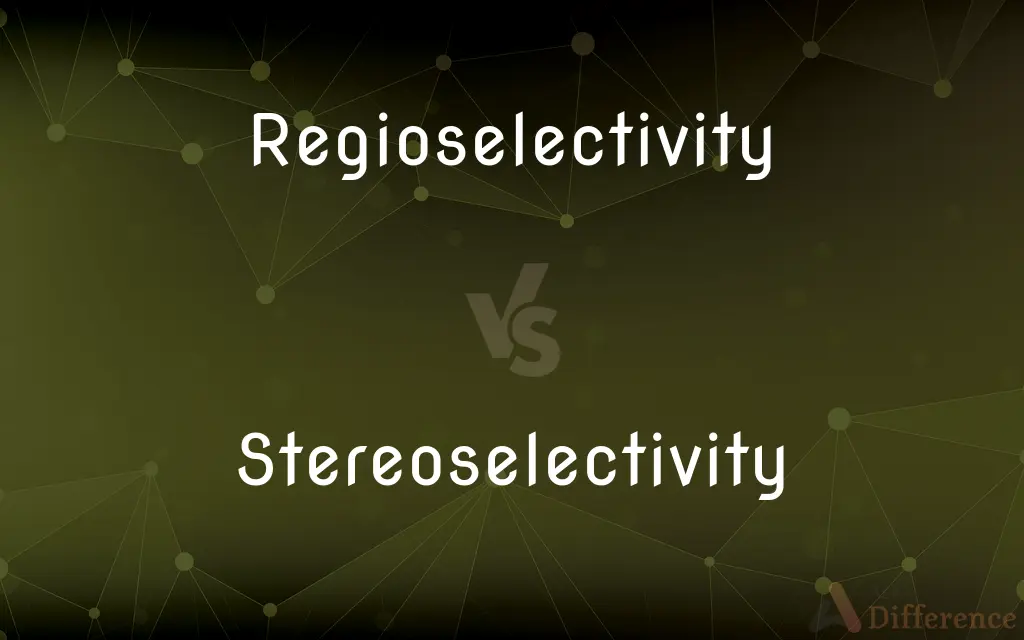Regioselectivity vs. Stereoselectivity — What's the Difference?
By Urooj Arif & Maham Liaqat — Updated on March 25, 2024
Regioselectivity refers to the preference of a chemical reaction to occur at one specific position on a molecule over others, while stereoselectivity involves the preference for the formation of one stereoisomer over others during a chemical reaction.

Difference Between Regioselectivity and Stereoselectivity
Table of Contents
ADVERTISEMENT
Key Differences
Regioselectivity is a key concept in organic chemistry where a reaction preferentially targets one specific location or functional group in a molecule over others, significantly impacting the structure and properties of the resulting compound. This selectivity is often influenced by the electronic and steric properties of the substrate. In contrast, stereoselectivity focuses on the spatial arrangement of atoms, determining how the configuration of atoms in space is affected during a reaction, which can lead to the production of stereoisomers—molecules with the same formula but different three-dimensional orientations.
The principles of regioselectivity are crucial in the design of synthesis pathways, ensuring that reactions occur at the desired part of the molecule, which is especially important for complex organic syntheses. Whereas stereoselectivity is paramount in the synthesis of drugs and biologically active molecules, where the 3D orientation of a molecule can determine its biological activity and interaction with biological systems.
Regioselective reactions are influenced by factors such as the presence of electron-withdrawing or electron-donating groups, which can stabilize or destabilize intermediates, directing the reaction towards a particular region of the molecule. On the other hand, stereoselective reactions are guided by the arrangement of atoms and the steric hindrance around the reactive site, which can favor the formation of one stereoisomer over another.
An example of regioselectivity is seen in the Markovnikov addition of hydrohalic acids to alkenes, where the acid adds to the more substituted carbon due to the stability of the resulting carbocation. In contrast, an example of stereoselectivity is the syn addition in hydrogenation reactions, where hydrogen atoms add to the same side of a double bond, leading to the formation of a specific stereoisomer.
Understanding the concepts of regioselectivity and stereoselectivity is essential for chemists to manipulate chemical reactions to achieve desired outcomes, whether they are aiming to produce a compound with specific functional groups in certain positions (regioselectivity) or to generate a compound with a particular three-dimensional arrangement (stereoselectivity).
ADVERTISEMENT
Comparison Chart
Definition
Preference for a reaction to occur at one specific site over others in a molecule
Preference for forming one stereoisomer over others
Influencing Factors
Electronic and steric properties, functional groups
Steric hindrance, arrangement of atoms around reactive site
Impact
Determines the structural isomer formed
Determines the spatial arrangement of atoms (3D structure)
Importance
Essential in synthesis pathways for correct functional group placement
Crucial for the activity and properties of biomolecules and drugs
Example Reactions
Markovnikov addition of hydrohalic acids to alkenes
Syn addition in hydrogenation reactions
Compare with Definitions
Regioselectivity
Regioselectivity determines where a chemical reaction predominantly occurs on a molecule.
In the hydroboration-oxidation of alkenes, regioselectivity results in the formation of alcohols at the less substituted carbon.
Stereoselectivity
It plays a crucial role in the biological activity of molecules, as different stereoisomers can have vastly different effects.
The stereoselective synthesis of a drug can ensure that only the active enantiomer is produced, minimizing side effects.
Regioselectivity
It is influenced by the molecule's structure and the presence of functional groups.
Electrophilic aromatic substitution in toluene preferentially occurs at the para and ortho positions due to the methyl group's electron-donating effect.
Stereoselectivity
Stereoselectivity is about the preference for forming one stereoisomer when several are possible.
In asymmetric synthesis, stereoselective catalysts lead to the predominance of one enantiomer over the other.
Regioselectivity
Regioselective reactions are key in designing drugs to ensure the correct placement of functional groups.
The regioselective alkylation of an aromatic compound can significantly influence its pharmacological properties.
Stereoselectivity
Understanding stereoselectivity is crucial in the development of pharmaceuticals to ensure efficacy and safety.
The stereoselective synthesis of anti-inflammatory drugs is important to target specific pathways without off-target effects.
Regioselectivity
Regioselectivity is essential in organic synthesis to avoid the production of unwanted isomers.
In the synthesis of complex natural products, regioselectivity ensures the introduction of functional groups at the correct positions.
Stereoselectivity
Reaction mechanisms can be designed to favor the formation of a specific stereoisomer.
Diastereoselective aldol reactions can be controlled to preferentially form one diastereomer based on steric and electronic factors.
Regioselectivity
Catalysts and reaction conditions can be optimized to enhance regioselectivity.
Using a specific catalyst in a C-H activation reaction can increase regioselectivity towards more accessible positions on the molecule.
Stereoselectivity
Stereoselectivity is often achieved by using chiral catalysts or reagents.
The use of a chiral phosphine catalyst in a hydrogenation reaction can lead to high enantioselectivity.
Regioselectivity
In chemistry, regioselectivity is the preference of chemical bonding or breaking in one direction over all other possible directions. It can often apply to which of many possible positions a reagent will affect, such as which proton a strong base will abstract from an organic molecule, or where on a substituted benzene ring a further substituent will be added A specific example is a halohydrin formation reaction with 2-propenylbenzene: Because of the preference for the formation of one product over another, the reaction is selective.
Stereoselectivity
In chemistry, stereoselectivity is the property of a chemical reaction in which a single reactant forms an unequal mixture of stereoisomers during a non-stereospecific creation of a new stereocenter or during a non-stereospecific transformation of a pre-existing one. The selectivity arises from differences in steric effects and electronic effects in the mechanistic pathways leading to the different products.
Regioselectivity
(uncountable) The condition of being regioselective.
Stereoselectivity
(chemistry) The condition of being stereoselective or a measure of the extent to which a reaction is stereoselective
[http://www.sigmaaldrich.com/etc/medialib/docs/Aldrich/Acta/al_acta_30_01.pdf Aldrichimica Acta Volume 30 No 4] (pdf) from [http://www.sigmaaldrich.com/chemistry/chemical-synthesis/learning-center/aldrichimica-acta.html Sigma-Aldrich]
Regioselectivity
(countable) The degree to which a reaction is regioselective.
Common Curiosities
How does stereoselectivity affect drug efficacy?
Stereoselectivity can greatly influence a drug's efficacy because different stereoisomers of a drug can interact differently with biological targets, affecting potency and side effects.
How is stereoselectivity controlled in a chemical reaction?
Stereoselectivity can be controlled through the choice of reagents, catalysts, and reaction conditions that favor the formation of one stereoisomer, often using principles of chiral chemistry.
Why is regioselectivity important in chemical synthesis?
Regioselectivity is crucial for accurately placing functional groups within a molecule, which determines the molecule's properties and reactivity, essential in complex organic synthesis and pharmaceuticals.
Can a reaction be both regioselective and stereoselective?
Yes, many reactions are both regioselective and stereoselective, meaning they prefer a specific site on the molecule and a specific spatial arrangement, crucial for synthesizing complex organic molecules.
What factors influence regioselectivity in a reaction?
Factors such as the electronic nature of substituents, steric hindrance, and the stability of intermediates influence regioselectivity by affecting the reactivity of different sites on a molecule.
How do chemists test for regioselectivity in a laboratory setting?
Chemists often use analytical techniques like NMR spectroscopy, mass spectrometry, or X-ray crystallography to determine the regioselectivity of a reaction by analyzing the structure of the product.
What is the significance of stereoselectivity in nature?
In nature, stereoselectivity is fundamental because biological systems are highly stereospecific, where the 3D arrangement of molecules can determine their biological function and interaction with enzymes.
How do enzymes exhibit stereoselectivity in biological reactions?
Enzymes are highly stereoselective catalysts due to their chiral active sites, which precisely fit only one enantiomer of a substrate, leading to the formation of specific stereoisomers in biochemical reactions.
How is regioselectivity modeled or predicted in computational chemistry?
Computational chemists use molecular modeling and quantum chemical calculations to predict regioselectivity by evaluating the stability of transition states and intermediates in various reaction pathways.
What are the environmental implications of stereoselectivity in pesticides and pharmaceuticals?
The stereoselectivity of pesticides and pharmaceuticals can have significant environmental implications, as certain stereoisomers may be more toxic or persistent in the environment, affecting ecosystems and water sources.
In what ways is regioselectivity crucial for material science?
In material science, regioselectivity is important for the synthesis of polymers and nanomaterials, where the placement of functional groups can influence the material's properties, such as conductivity, strength, and reactivity.
What role does stereoselectivity play in sensory perception, such as taste and smell?
Stereoselectivity is crucial in sensory perception as different enantiomers of a compound can have distinct smells or tastes due to the stereospecific interaction with receptors in the nose and taste buds.
Can regioselectivity be altered by changing the solvent or temperature of a reaction?
Yes, reaction conditions such as solvent, temperature, and pressure can influence regioselectivity by affecting the stability and reactivity of intermediates, leading to different reaction pathways being favored.
Share Your Discovery

Previous Comparison
Might vs. Maybe
Next Comparison
Biosphere vs. LithosphereAuthor Spotlight
Written by
Urooj ArifUrooj is a skilled content writer at Ask Difference, known for her exceptional ability to simplify complex topics into engaging and informative content. With a passion for research and a flair for clear, concise writing, she consistently delivers articles that resonate with our diverse audience.
Co-written by
Maham Liaqat













































